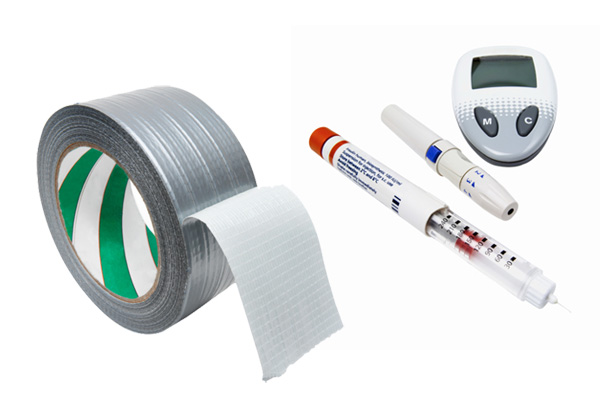You Can’t “Duct Tape” Diabetes Problems

When you have a leaky hose or loose window screen, do you pull out your handy role of silver duct tape and give it a quick fix? That may work for problems around the house, but a duct tape-style repair is no good for your diabetes control. If you often “duct tape” your blood glucose highs with more insulin and your lows with sugary treats, you are doing quick fixes for problems that need better care before they occur.
Below are some ways to help you keep your blood glucose in your target range:
Check Your Blood
Ask your healthcare team about blood testing times that are right for you. Your test results help you and your team members find problems in your care plan.
If you test in the morning before you eat, the American Diabetes Association suggests you aim for a level between 70-130 mg/dL at that time.
If you check your blood two hours after the first bite of a meal, you can use that result to help make better food choices. Try to keep your level below 180 gm/dL or within the level suggested by your team.
If your blood glucose level is too high, it is likely that you either:
- Ate too much carbohydrate-containing food
- Did not take enough medicine, or
- Need to move more
Follow or Change Your Meal Plan
Do you skip meals or eat too many starchy or sweet snacks? All can send your blood-glucose level on a roller coaster ride of highs and lows. If your meal plan is too hard for you to stick with, change it.
Meet with a registered dietitian. Ask him or her to adjust your meal plan to fit your health goals and your life.
Prevent Night-Time Lows
If you know that your blood glucose level drops while you are asleep, eat a snack bar that helps you maintain your blood glucose level before you going to bed. One brand is ExtendBar. These snacks contain a form of carbohydrate that breaks down slowly in your body throughout the night and helps keep your blood glucose level from dropping.
An insulin pump can also help you keep your glucose levels under control at night. A continuous glucose monitor can warn you if you are about to have a low.
Reduce your Stress Level
Most of us run around like chickens without heads throughout the day. We get upset at work and annoyed in traffic jams. Stress can cause blood glucose levels to climb, no matter how well you eat or how often you exercise.
Cut out or limit things that stress you. Take at least 15 minutes of down time each day to relax, read, take a brief bath, stretch, meditate or do something quiet that you enjoy.
Move More
Exercise is a great way to help keep your blood glucose under control. If you don’t have time to go to a gym, wear a pedometer. It is a small device that counts the number of steps you take. Wear it for a single week. Note your average daily step total and set a goal – your daily step total plus 1,000 more steps. To meet that goal simply add a few steps to each task you do.

